Week 15(1).pptx
Download as pptx, pdf0 likes10 views
Virtual reality uses headsets with built-in displays and sensors to create stereoscopic 3D environments that respond to the user's head movements, allowing them to look around. Additional devices like controllers can provide haptic feedback and enable interaction. This transports users to new virtual places and opens educational possibilities in physical sciences by simulating sights, sounds, and touch. Popular game engines like Unity, Unreal Engine, and Godot support virtual reality development and provide tools for creating immersive VR experiences across multiple platforms.
1 of 15
Download to read offline
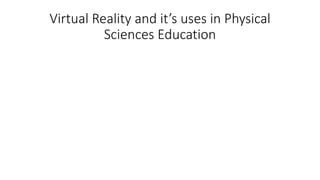
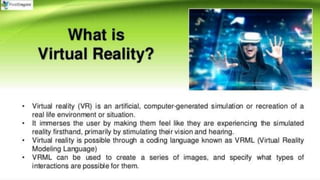
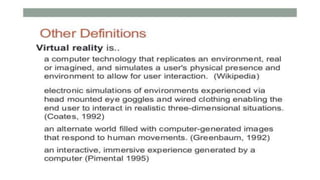
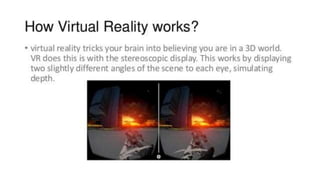

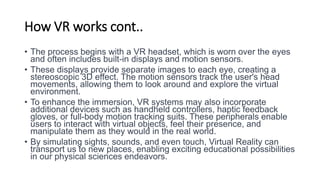
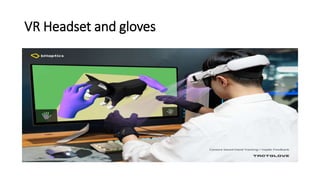
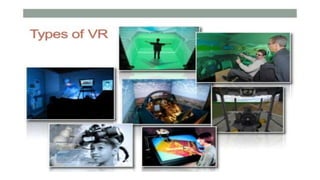




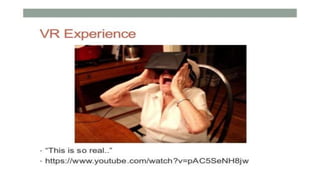


Ad
Recommended
Handout level-1-module-1
Handout level-1-module-1SV.CO
Ěý
The document provides an overview of virtual reality (VR), augmented reality (AR), and extended reality (XR). It defines each term and describes some of the key principles and technologies that enable VR experiences. VR creates simulated, immersive environments, while AR layers virtual information over the real world. XR encompasses all real-and-virtual combined environments enabled by technology. The document then discusses some of the technical advances that have made VR possible, such as head-mounted displays, motion tracking, 3D displays, and haptics. It also notes some ongoing challenges to improving the realism of VR experiences.Virtual Riality in simulation gaming and idk.pptx
Virtual Riality in simulation gaming and idk.pptxssuser0b0103
Ěý
The document provides an overview of virtual reality (VR), detailing its history, types, and applications across various fields. It traces the evolution of VR from early concepts in the 19th century to modern advancements, highlighting significant developments such as the Oculus Rift. Additionally, it discusses the advantages and disadvantages of VR, including its utility in training and therapy, while also addressing concerns related to escapism and high costs.Virtual reality.pptx
Virtual reality.pptxB05AvaniKushwaha
Ěý
The document discusses virtual reality (VR), defining it as a simulated 3D environment that users can explore and interact with using specialized devices. It outlines the history, types, architecture, software, hardware, and applications of VR across various sectors including healthcare, military, education, and entertainment. The future of VR looks promising with projected growth and advancements in technology aimed at increasing accessibility and improving user experience.Virtual Reality
Virtual Reality Rashmi Bhat
Ěý
Virtual reality (VR) uses computer-generated environments to simulate realistic experiences. VR headsets use displays and lenses to create stereoscopic 3D images that trick the brain into perceiving the virtual environment as reality. Special hardware like head-mounted displays, motion trackers, and controllers allow users to interact with and immerse themselves in virtual worlds. The history of VR began in the 1930s with science fiction concepts, and continued to evolve with early head-mounted displays in the 1960s. Today, VR is used across many industries like gaming, real estate, education, and more.Introduction_to_jrnvjenrjvnVirtual-Reality.pptx
Introduction_to_jrnvjenrjvnVirtual-Reality.pptxManthan689286
Ěý
Virtual reality (VR) is a computer-generated immersive simulation that enables real-time interactions within an interactive 3D environment, utilizing specialized hardware such as headsets and motion tracking devices. It comprises various types, including immersive, non-immersive, augmented reality (AR), and mixed reality (MR), each serving unique applications across industries like gaming, education, and healthcare. The development of input and output devices such as motion controllers, haptic gloves, and spatial audio systems enhances user engagement and realism in these virtual experiences.Virtual reality
Virtual realityHarshitha ram
Ěý
Virtual reality (VR) is an artificial environment created through computer technology that allows users to interact with simulated worlds. It has a rich history dating back to the 1950s with various devices like head-mounted displays and cave systems enhancing the experience, and it is widely used in fields such as healthcare and entertainment. Despite its advantages in visualization and interaction, VR faces challenges like lack of standardization and ongoing medical application issues.Virtual reality
Virtual realityHarsh Verma
Ěý
The document discusses the concept and history of virtual reality (VR), detailing its evolution from early inventions in the 1950s to modern applications across various fields such as education, military, healthcare, and electrical engineering. It highlights the types, components, advantages, and disadvantages of VR, emphasizing its immersive capabilities and future potential for enhancing virtual simulations and training environments. The conclusion underscores VR's promise as a transformative technology that creates new opportunities for learning and safety.V r 2.o
V r 2.ovetchakishore
Ěý
This document provides an overview of virtual reality (VR), including:
- VR allows users to interact with simulated 3D environments through electronic devices like goggles.
- The first VR experience was called Sensorama in 1957. NASA developed early VR headsets in the 1980s.
- Modern VR headsets use screens, sensors for head tracking, and audio to immerse users in 3D virtual worlds. Software is developed using programming languages like C++.
- VR works by simulating real presence using computer-generated imagery and content across the senses like sight and sound. Sensors like gyroscopes track head motion to update the virtual view.Virtual Reality & Augmented Reality
Virtual Reality & Augmented RealityRajesh Yadav
Ěý
Virtual reality creates realistic virtual environments that users can interact with via specialized equipment like headsets. Augmented reality overlays digital objects and information on the real world. Both technologies use displays, sensors, and other hardware components to blend virtual and real experiences. Common applications include education, training, gaming, and consumer/industrial design. While providing immersive experiences, these technologies also face challenges related to cost, privacy, and technical limitations that researchers continue working to overcome.nkllml;m;llkmlmljkjiuhihkjnklnjkhjgjk.ppt
nkllml;m;llkmlmljkjiuhihkjnklnjkhjgjk.pptJITENDER773791
Ěý
The document introduces virtual reality (VR) as a computer-generated immersive environment with various types, including immersive, telepresence, and mixed reality. It discusses VR hardware components, such as image generators, manipulation devices, and stereo vision, essential for creating a realistic virtual experience. Additionally, it outlines multiple applications of VR across fields like architecture, medicine, engineering, entertainment, and training, emphasizing its value in modeling, diagnostics, and simulations.C. VR intrduction_lecture for introduction to VR Lecture-1.pptx
C. VR intrduction_lecture for introduction to VR Lecture-1.pptxRajGopalMishra4
Ěý
Virtual reality creates realistic virtual worlds that users can interact with via specialized equipment like headsets. Augmented reality overlays virtual objects onto the real world. Both technologies use displays, sensors and other hardware to blend virtual and real environments. They have applications in education, training, design, and entertainment. While providing immersive experiences, they also face challenges related to cost, privacy and technical limitations that researchers continue working to overcome.presentation1-180123jjjjjjjj150728_2.pdf
presentation1-180123jjjjjjjj150728_2.pdfreler89973
Ěý
Virtual reality creates realistic virtual worlds that users can interact with via specialized equipment like headsets. Augmented reality overlays virtual objects onto the real world. Both technologies use displays, sensors and other hardware to blend virtual and real environments. They have applications in education, training, design, and entertainment. While providing immersive experiences, they also have limitations around cost, privacy and performance that must be addressed for wider adoption. Overall, VR and AR show promise for many future uses as the technologies continue advancing.Introduction -to- Virtual - Reality.pptx
Introduction -to- Virtual - Reality.pptxhariomdeore
Ěý
Virtual reality (VR) immerses users in computer-generated environments, evolving from early concepts in the 1950s to modern mainstream applications. Key components of VR include headsets, controllers, and sensors that facilitate interactive experiences in gaming, entertainment, and education. Although VR holds potential for training and therapy, challenges such as motion sickness and accessibility issues remain.Virtual reality
Virtual realityHarshit Sankhla
Ěý
The document discusses virtual reality (VR), a technology that simulates immersive environments for user interaction, outlining its history from the 1960s to recent advancements. It covers the types of VR devices, such as head-mounted displays and input controllers, and explores their applications in various fields including entertainment, medicine, and education. The document also addresses challenges such as cybersickness and the high cost of systems, as well as potential future developments like augmented reality.Virtual reality
Virtual realityShakib Sarar Arnab
Ěý
Virtual reality (VR) is the immersive experience of simulated environments created by computers, historically developing since the 1950s with advancements in technology. VR systems come in three types: non-immersive, augmented, and immersive, each utilizing various hardware like head-mounted displays and motion trackers for different applications in fields such as engineering, healthcare, and entertainment. The future of VR is promising as technology evolves, with increasing demand for VR programming and potential shifts in user interfaces.Virtual reality
Virtual realityShivam Londhe
Ěý
Virtual reality (VR) uses headsets to immerse users in simulated, three-dimensional environments by generating realistic images, sounds and sensations. VR originated in the 1950s with devices like the Sensorama simulator and Telesphere Mask head-mounted display. Modern VR is driven by smartphone technologies like motion sensors and HD screens. It has various applications like education, entertainment, military training and space exploration. While VR offers advantages like hands-on training without risk, it also faces challenges like high costs, visual fatigue and potentially reduced human interaction.week 1, VR and AR presentation - Reema Albouainain
week 1, VR and AR presentation - Reema Albouainainreemakb03
Ěý
The document provides an overview of mixed reality technologies, specifically focusing on virtual reality (VR) and augmented reality (AR) tools and applications. It details key VR headsets like the Oculus Quest 2 and HTC Vive, as well as AR technologies such as Google ARCore and Microsoft HoloLens, while discussing their benefits, uses, and associated costs. Additionally, it addresses technical limitations and health concerns related to VR and AR experiences.Virtual reality and VR glasses
Virtual reality and VR glasses Anuj Singh Rajput
Ěý
This document summarizes a seminar about virtual reality. It defines virtual reality as an imaginary world simulated by a computer that senses feed to our brain. It discusses the history of virtual reality from early devices in the 1950s to modern head mounted displays. It also describes technologies used in virtual reality like HMDs, CAVEs, data gloves, and data suits. Applications of virtual reality discussed include business, training, engineering, medicine, and entertainment. Potential disadvantages around social isolation and eye strain are also noted.Augumeted reality and virtual reality vs VR.pptx
Augumeted reality and virtual reality vs VR.pptxThePower15
Ěý
This document covers augmented reality (AR) and virtual reality (VR). It defines AR as technology that superimposes digital images onto the real world, typically through a device, while VR immerses users in a simulated digital environment using headsets. The document discusses how each works, providing examples of AR apps. It outlines advantages like enhanced experiences for AR and exploring places for VR. However, both rely on technology, posing issues like battery drain and privacy concerns for AR or implementation costs for VR. The document concludes by listing VR applications in fields like military, sports, and medicine.Argumented vs vertual Presentation1.pptx
Argumented vs vertual Presentation1.pptxBetshaTizazu1
Ěý
Virtual reality (VR) is a computer-generated simulation that immerses users in an artificial environment, typically using headsets, while augmented reality (AR) overlays digital elements onto the real world through mobile devices. Both technologies share similarities in entertainment and potential applications in medicine but differ in purpose, with VR creating a separate reality and AR enhancing real experiences. VR and AR can also work together to create more engaging and interactive experiences.Virtual reality
Virtual realityAnuj Singh Rajput
Ěý
The document outlines a seminar on virtual reality, covering its definition, history, devices, applications, and disadvantages. It explains how virtual reality creates an imaginary world through simulations and discusses various uses in sectors such as business, training, engineering, and healthcare. Additionally, it highlights concerns regarding social isolation and psychological effects associated with VR usage.Virtual reality & vr glasses
Virtual reality & vr glassesAnuj Singh Rajput
Ěý
Virtual reality uses head-mounted displays or multi-projected environments to immerse users in simulated, three-dimensional worlds. The history of VR began in the 1950s with devices like the Sensorama, and early innovators included Morton Heilig, Ivan Sutherland and Jaron Lanier. Modern VR uses HMDs like the Oculus Rift along with motion tracking and controllers. It has applications in gaming, training, engineering, and healthcare. While VR offers opportunities, overuse can cause social isolation, psychological effects, and eye/hearing problems.Virtual reality & vr glasses
Virtual reality & vr glassesAnuj Singh Rajput
Ěý
The document outlines a seminar on virtual reality (VR), covering its definition, history, and devices used, as well as its applications across various sectors such as business, training, and healthcare. It highlights the advantages of VR, such as immersive experiences and training opportunities, while also addressing disadvantages including social isolation and potential health effects. The conclusion emphasizes the growth of the VR industry and the expectation of more advanced computing capabilities by 2037.Chapter -5- Augumented Reality (AR).pptx
Chapter -5- Augumented Reality (AR).pptxbalewayalew
Ěý
This document discusses augmented reality (AR), virtual reality (VR), and mixed reality (MR). It defines each term and distinguishes the key differences. AR overlays digital content on the real world, VR fully immerses users in virtual environments, and MR merges real and virtual worlds. The document also covers AR architectures, applications in education, medicine, and entertainment, and provides examples of AR, VR, and MR systems and devices.vr
vrZheenHandren
Ěý
Virtual reality is a 3D computer-generated environment that users can interact with and become immersed in. There are three main types of virtual reality: fully-immersive simulations which use head-mounted displays for a realistic experience; semi-immersive simulations which provide a partially virtual environment mainly used for education and training; and non-immersive simulations which do not provide immersion but allow interaction through input devices like keyboards and mice. Virtual reality has applications in education, healthcare, and entertainment.Virtual reality
Virtual realitychahat aggarwal
Ěý
Virtual reality is an artificial environment that is created with software and presented to the user through interactive devices. It involves immersing the senses in a 3D computer-generated world. The history of VR began in the 1950s with flight simulators for pilots. Major developments included research programs in the 1960s, commercial development in the 1980s, and the first commercial entertainment system in the early 1990s. There are different types of VR including immersive VR, augmented VR, video mapping, and desktop VR. Popular applications of VR include gaming, education, and training. The Oculus Rift is a virtual reality headset that provides an immersive stereoscopic 3D viewing experience.Virtual reality and its Types
Virtual reality and its TypesShakaib123
Ěý
Virtual reality (VR) refers to a three-dimensional, computer-generated environment that users can explore and interact with, creating a sense of presence through various hardware like headsets and motion devices. It has applications across entertainment, education, healthcare, and military sectors, which makes its development significant despite the complex technology and costs involved. Types of VR include immersive, non-immersive, and semi-immersive systems, with notable VR headsets from 2018 including Oculus Rift, Sony PlayStation VR, and HTC Vive.Virtual reality vs augumented reality reality
Virtual reality vs augumented reality realitysubashinibalamurugan
Ěý
Virtual reality vs augumented reality Code Profiling in Odoo 18 - Odoo 18 şÝşÝߣs
Code Profiling in Odoo 18 - Odoo 18 şÝşÝߣsCeline George
Ěý
Profiling in Odoo identifies slow code and resource-heavy processes, ensuring better system performance. Odoo code profiling detects bottlenecks in custom modules, making it easier to improve speed and scalability.How payment terms are configured in Odoo 18
How payment terms are configured in Odoo 18Celine George
Ěý
Payment terms in Odoo 18 help define the conditions for when invoices are due. This feature can split payments into multiple parts and automate due dates based on specific rules.More Related Content
Similar to Week 15(1).pptx (20)
Virtual Reality & Augmented Reality
Virtual Reality & Augmented RealityRajesh Yadav
Ěý
Virtual reality creates realistic virtual environments that users can interact with via specialized equipment like headsets. Augmented reality overlays digital objects and information on the real world. Both technologies use displays, sensors, and other hardware components to blend virtual and real experiences. Common applications include education, training, gaming, and consumer/industrial design. While providing immersive experiences, these technologies also face challenges related to cost, privacy, and technical limitations that researchers continue working to overcome.nkllml;m;llkmlmljkjiuhihkjnklnjkhjgjk.ppt
nkllml;m;llkmlmljkjiuhihkjnklnjkhjgjk.pptJITENDER773791
Ěý
The document introduces virtual reality (VR) as a computer-generated immersive environment with various types, including immersive, telepresence, and mixed reality. It discusses VR hardware components, such as image generators, manipulation devices, and stereo vision, essential for creating a realistic virtual experience. Additionally, it outlines multiple applications of VR across fields like architecture, medicine, engineering, entertainment, and training, emphasizing its value in modeling, diagnostics, and simulations.C. VR intrduction_lecture for introduction to VR Lecture-1.pptx
C. VR intrduction_lecture for introduction to VR Lecture-1.pptxRajGopalMishra4
Ěý
Virtual reality creates realistic virtual worlds that users can interact with via specialized equipment like headsets. Augmented reality overlays virtual objects onto the real world. Both technologies use displays, sensors and other hardware to blend virtual and real environments. They have applications in education, training, design, and entertainment. While providing immersive experiences, they also face challenges related to cost, privacy and technical limitations that researchers continue working to overcome.presentation1-180123jjjjjjjj150728_2.pdf
presentation1-180123jjjjjjjj150728_2.pdfreler89973
Ěý
Virtual reality creates realistic virtual worlds that users can interact with via specialized equipment like headsets. Augmented reality overlays virtual objects onto the real world. Both technologies use displays, sensors and other hardware to blend virtual and real environments. They have applications in education, training, design, and entertainment. While providing immersive experiences, they also have limitations around cost, privacy and performance that must be addressed for wider adoption. Overall, VR and AR show promise for many future uses as the technologies continue advancing.Introduction -to- Virtual - Reality.pptx
Introduction -to- Virtual - Reality.pptxhariomdeore
Ěý
Virtual reality (VR) immerses users in computer-generated environments, evolving from early concepts in the 1950s to modern mainstream applications. Key components of VR include headsets, controllers, and sensors that facilitate interactive experiences in gaming, entertainment, and education. Although VR holds potential for training and therapy, challenges such as motion sickness and accessibility issues remain.Virtual reality
Virtual realityHarshit Sankhla
Ěý
The document discusses virtual reality (VR), a technology that simulates immersive environments for user interaction, outlining its history from the 1960s to recent advancements. It covers the types of VR devices, such as head-mounted displays and input controllers, and explores their applications in various fields including entertainment, medicine, and education. The document also addresses challenges such as cybersickness and the high cost of systems, as well as potential future developments like augmented reality.Virtual reality
Virtual realityShakib Sarar Arnab
Ěý
Virtual reality (VR) is the immersive experience of simulated environments created by computers, historically developing since the 1950s with advancements in technology. VR systems come in three types: non-immersive, augmented, and immersive, each utilizing various hardware like head-mounted displays and motion trackers for different applications in fields such as engineering, healthcare, and entertainment. The future of VR is promising as technology evolves, with increasing demand for VR programming and potential shifts in user interfaces.Virtual reality
Virtual realityShivam Londhe
Ěý
Virtual reality (VR) uses headsets to immerse users in simulated, three-dimensional environments by generating realistic images, sounds and sensations. VR originated in the 1950s with devices like the Sensorama simulator and Telesphere Mask head-mounted display. Modern VR is driven by smartphone technologies like motion sensors and HD screens. It has various applications like education, entertainment, military training and space exploration. While VR offers advantages like hands-on training without risk, it also faces challenges like high costs, visual fatigue and potentially reduced human interaction.week 1, VR and AR presentation - Reema Albouainain
week 1, VR and AR presentation - Reema Albouainainreemakb03
Ěý
The document provides an overview of mixed reality technologies, specifically focusing on virtual reality (VR) and augmented reality (AR) tools and applications. It details key VR headsets like the Oculus Quest 2 and HTC Vive, as well as AR technologies such as Google ARCore and Microsoft HoloLens, while discussing their benefits, uses, and associated costs. Additionally, it addresses technical limitations and health concerns related to VR and AR experiences.Virtual reality and VR glasses
Virtual reality and VR glasses Anuj Singh Rajput
Ěý
This document summarizes a seminar about virtual reality. It defines virtual reality as an imaginary world simulated by a computer that senses feed to our brain. It discusses the history of virtual reality from early devices in the 1950s to modern head mounted displays. It also describes technologies used in virtual reality like HMDs, CAVEs, data gloves, and data suits. Applications of virtual reality discussed include business, training, engineering, medicine, and entertainment. Potential disadvantages around social isolation and eye strain are also noted.Augumeted reality and virtual reality vs VR.pptx
Augumeted reality and virtual reality vs VR.pptxThePower15
Ěý
This document covers augmented reality (AR) and virtual reality (VR). It defines AR as technology that superimposes digital images onto the real world, typically through a device, while VR immerses users in a simulated digital environment using headsets. The document discusses how each works, providing examples of AR apps. It outlines advantages like enhanced experiences for AR and exploring places for VR. However, both rely on technology, posing issues like battery drain and privacy concerns for AR or implementation costs for VR. The document concludes by listing VR applications in fields like military, sports, and medicine.Argumented vs vertual Presentation1.pptx
Argumented vs vertual Presentation1.pptxBetshaTizazu1
Ěý
Virtual reality (VR) is a computer-generated simulation that immerses users in an artificial environment, typically using headsets, while augmented reality (AR) overlays digital elements onto the real world through mobile devices. Both technologies share similarities in entertainment and potential applications in medicine but differ in purpose, with VR creating a separate reality and AR enhancing real experiences. VR and AR can also work together to create more engaging and interactive experiences.Virtual reality
Virtual realityAnuj Singh Rajput
Ěý
The document outlines a seminar on virtual reality, covering its definition, history, devices, applications, and disadvantages. It explains how virtual reality creates an imaginary world through simulations and discusses various uses in sectors such as business, training, engineering, and healthcare. Additionally, it highlights concerns regarding social isolation and psychological effects associated with VR usage.Virtual reality & vr glasses
Virtual reality & vr glassesAnuj Singh Rajput
Ěý
Virtual reality uses head-mounted displays or multi-projected environments to immerse users in simulated, three-dimensional worlds. The history of VR began in the 1950s with devices like the Sensorama, and early innovators included Morton Heilig, Ivan Sutherland and Jaron Lanier. Modern VR uses HMDs like the Oculus Rift along with motion tracking and controllers. It has applications in gaming, training, engineering, and healthcare. While VR offers opportunities, overuse can cause social isolation, psychological effects, and eye/hearing problems.Virtual reality & vr glasses
Virtual reality & vr glassesAnuj Singh Rajput
Ěý
The document outlines a seminar on virtual reality (VR), covering its definition, history, and devices used, as well as its applications across various sectors such as business, training, and healthcare. It highlights the advantages of VR, such as immersive experiences and training opportunities, while also addressing disadvantages including social isolation and potential health effects. The conclusion emphasizes the growth of the VR industry and the expectation of more advanced computing capabilities by 2037.Chapter -5- Augumented Reality (AR).pptx
Chapter -5- Augumented Reality (AR).pptxbalewayalew
Ěý
This document discusses augmented reality (AR), virtual reality (VR), and mixed reality (MR). It defines each term and distinguishes the key differences. AR overlays digital content on the real world, VR fully immerses users in virtual environments, and MR merges real and virtual worlds. The document also covers AR architectures, applications in education, medicine, and entertainment, and provides examples of AR, VR, and MR systems and devices.vr
vrZheenHandren
Ěý
Virtual reality is a 3D computer-generated environment that users can interact with and become immersed in. There are three main types of virtual reality: fully-immersive simulations which use head-mounted displays for a realistic experience; semi-immersive simulations which provide a partially virtual environment mainly used for education and training; and non-immersive simulations which do not provide immersion but allow interaction through input devices like keyboards and mice. Virtual reality has applications in education, healthcare, and entertainment.Virtual reality
Virtual realitychahat aggarwal
Ěý
Virtual reality is an artificial environment that is created with software and presented to the user through interactive devices. It involves immersing the senses in a 3D computer-generated world. The history of VR began in the 1950s with flight simulators for pilots. Major developments included research programs in the 1960s, commercial development in the 1980s, and the first commercial entertainment system in the early 1990s. There are different types of VR including immersive VR, augmented VR, video mapping, and desktop VR. Popular applications of VR include gaming, education, and training. The Oculus Rift is a virtual reality headset that provides an immersive stereoscopic 3D viewing experience.Virtual reality and its Types
Virtual reality and its TypesShakaib123
Ěý
Virtual reality (VR) refers to a three-dimensional, computer-generated environment that users can explore and interact with, creating a sense of presence through various hardware like headsets and motion devices. It has applications across entertainment, education, healthcare, and military sectors, which makes its development significant despite the complex technology and costs involved. Types of VR include immersive, non-immersive, and semi-immersive systems, with notable VR headsets from 2018 including Oculus Rift, Sony PlayStation VR, and HTC Vive.Virtual reality vs augumented reality reality
Virtual reality vs augumented reality realitysubashinibalamurugan
Ěý
Virtual reality vs augumented reality Recently uploaded (20)
Code Profiling in Odoo 18 - Odoo 18 şÝşÝߣs
Code Profiling in Odoo 18 - Odoo 18 şÝşÝߣsCeline George
Ěý
Profiling in Odoo identifies slow code and resource-heavy processes, ensuring better system performance. Odoo code profiling detects bottlenecks in custom modules, making it easier to improve speed and scalability.How payment terms are configured in Odoo 18
How payment terms are configured in Odoo 18Celine George
Ěý
Payment terms in Odoo 18 help define the conditions for when invoices are due. This feature can split payments into multiple parts and automate due dates based on specific rules.Birnagar High School Platinum Jubilee Quiz.pptx
Birnagar High School Platinum Jubilee Quiz.pptxSourav Kr Podder
Ěý
Birnagar High School Platinum Jubilee Celebration QuizM&A5 Q1 1 differentiate evolving early Philippine conventional and contempora...
M&A5 Q1 1 differentiate evolving early Philippine conventional and contempora...ErlizaRosete
Ěý
MAPEH 6 QI WEEK ITHE PSYCHOANALYTIC OF THE BLACK CAT BY EDGAR ALLAN POE (1).pdf
THE PSYCHOANALYTIC OF THE BLACK CAT BY EDGAR ALLAN POE (1).pdfnabilahk908
Ěý
Psychoanalytic Analysis of The Black Cat by Edgar Allan Poe explores the deep psychological dimensions of the narrator’s disturbed mind through the lens of Sigmund Freud’s psychoanalytic theory. According to Freud (1923), the human psyche is structured into three components: the Id, which contains primitive and unconscious desires; the Ego, which operates on the reality principle and mediates between the Id and the external world; and the Superego, which reflects internalized moral standards.
In this story, Poe presents a narrator who experiences a psychological breakdown triggered by repressed guilt, aggression, and internal conflict. This analysis focuses not only on the gothic horror elements of the narrative but also on the narrator’s mental instability and emotional repression, demonstrating how the imbalance of these three psychic forces contributes to his downfall.SCHIZOPHRENIA OTHER PSYCHOTIC DISORDER LIKE Persistent delusion/Capgras syndr...
SCHIZOPHRENIA OTHER PSYCHOTIC DISORDER LIKE Persistent delusion/Capgras syndr...parmarjuli1412
Ěý
SCHIZOPHRENIA INCLUDED TOPIC IS INTRODUCTION, DEFINITION OF GENERAL TERM IN PSYCHIATRIC, THEN DIFINITION OF SCHIZOPHRENIA, EPIDERMIOLOGY, ETIOLOGICAL FACTORS, CLINICAL FEATURE(SIGN AND SYMPTOMS OF SCHIZOPHRENIA), CLINICAL TYPES OF SCHIZOPHRENIA, DIAGNOSIS, INVESTIGATION, TREATMENT MODALITIES(PHARMACOLOGICAL MANAGEMENT, PSYCHOTHERAPY, ECT, PSYCHO-SOCIO-REHABILITATION), NURSING MANAGEMENT(ASSESSMENT,DIAGNOSIS,NURSING INTERVENTION,AND EVALUATION), OTHER PSYCHOTIC DISORDER LIKE Persistent delusion/Capgras syndrome(The Delusion of Doubles)/Acute and Transient Psychotic Disorders/Induced Delusional Disorders/Schizoaffective Disorder /CAPGRAS SYNDROME(DELUSION OF DOUBLE), GERIATRIC CONSIDERATION, FOLLOW UP, HOMECARE AND REHABILITATION OF THE PATIENT, Tanja Vujicic - PISA for Schools contact Info
Tanja Vujicic - PISA for Schools contact InfoEduSkills OECD
Ěý
Tanja Vujicic, Senior Analyst and PISA for School’s Project Manager at the OECD spoke at the OECD webinar 'Turning insights into impact: What do early case studies reveal about the power of PISA for Schools?' on 20 June 2025
PISA for Schools is an OECD assessment that evaluates 15-year-old performance on reading, mathematics, and science. It also gathers insights into students’ learning environment, engagement and well-being, offering schools valuable data that help them benchmark performance internationally and improve education outcomes. A central ambition, and ongoing challenge, has been translating these insights into meaningful actions that drives lasting school improvement. This is why students from these 44 institutions have not received National Se...
This is why students from these 44 institutions have not received National Se...Kweku Zurek
Ěý
This is why students from these 44 institutions have not received National Service PIN codes (LIST)YSPH VMOC Special Report - Measles Outbreak Southwest US 6-14-2025.pptx
YSPH VMOC Special Report - Measles Outbreak Southwest US 6-14-2025.pptxYale School of Public Health - The Virtual Medical Operations Center (VMOC)
Ěý
BLUF:
The Texas outbreak has slowed down, but sporadic cases continue to emerge in Kansas, Oklahoma, and New Mexico.
Elsewhere in the US, we continue to see signs of acceleration due to outbreaks outside the Southwest (North Dakota, Montana, and Colorado) and travel-related cases. Measles exposures due to travel are expected to pose a significant challenge throughout the summer.
The U.S. is on track to exceed its 30-year high for measles cases (1,274) within the next two weeks.
Here is the latest update:
CURRENT CASE COUNT: 919
•Texas: 744 (+2) (55% of cases are in Gaines County).
•New Mexico: 81 (83% of cases are from Lea County).
•Oklahoma: 20 (+2)
•Kansas: 74 (+5) (38.89% of the cases are from Gray County).
HOSPITALIZATIONS: 104
• Texas: 96 (+2) – This accounts for 13% of all cases in Texas.
• New Mexico: 7 – This accounts for 9.47% of all cases in New Mexico.
• Kansas: 3 – This accounts for 5.08% of all cases in the state of Kansas.
DEATHS: 3
•Texas: 2 – This is 0.27% of all cases in Texas.
•New Mexico: 1 – This is 1.23% of all cases in New Mexico.
US NATIONAL CASE COUNT: 1,197
INTERNATIONAL SPREAD
•Mexico: 2337 (+257), 5 fatalities
‒Chihuahua, Mexico: 2,179 (+239) cases, 4 fatalities, 7 currently hospitalized.
•Canada: 3,207 (+208), 1 fatality
‒Ontario Outbreak, Canada: 2,115 (+74) cases, 158 hospitalizations, 1 fatality.
‒Alberta, Canada: 879(+118) cases, 5 currently hospitalized.K12 Tableau User Group virtual event June 18, 2025
K12 Tableau User Group virtual event June 18, 2025dogden2
Ěý
National K12 Tableau User Group: June 2025 meeting slidesECONOMICS, DISASTER MANAGEMENT, ROAD SAFETY - STUDY MATERIAL [10TH]
ECONOMICS, DISASTER MANAGEMENT, ROAD SAFETY - STUDY MATERIAL [10TH]SHERAZ AHMAD LONE
Ěý
This study material for Class 10th covers the core subjects of Economics, Disaster Management, and Road Safety Education, developed strictly in line with the JKBOSE textbook. It presents the content in a simplified, structured, and student-friendly format, ensuring clarity in concepts. The material includes reframed explanations, flowcharts, infographics, and key point summaries to support better understanding and retention. Designed for classroom teaching and exam preparation, it aims to enhance comprehension, critical thinking, and practical awareness among students.How to use search fetch method in Odoo 18
How to use search fetch method in Odoo 18Celine George
Ěý
The search_fetch is a powerful ORM method used in Odoo for some specific addons to combine the functionality of search and read for more efficient data fetching. It might be used to search for records and fetch specific fields in a single call. It stores the result in the cache memory.How to Customize Quotation Layouts in Odoo 18
How to Customize Quotation Layouts in Odoo 18Celine George
Ěý
Customizing quotation layouts in Odoo 18 allows businesses to personalize their quotations to match branding or specific requirements. This can include adding logos, custom fields, or modifying headers and footers. Peer Teaching Observations During School Internship
Peer Teaching Observations During School InternshipAjayaMohanty7
Ěý
FOR B.ED,M.ED,M.A.EDUCATION AND ANY STUDENT OF TEACHER EDUCATIONPests of Maize: An comprehensive overview.pptx
Pests of Maize: An comprehensive overview.pptxArshad Shaikh
Ěý
Maize is susceptible to various pests that can significantly impact yields. Key pests include the fall armyworm, stem borers, cob earworms, shoot fly. These pests can cause extensive damage, from leaf feeding and stalk tunneling to grain destruction. Effective management strategies, such as integrated pest management (IPM), resistant varieties, biological control, and judicious use of chemicals, are essential to mitigate losses and ensure sustainable maize production.VCE Literature Section A Exam Response Guide
VCE Literature Section A Exam Response Guidejpinnuck
Ěý
This practical guide shows students of Unit 3&4 VCE Literature how to write responses to Section A of the exam. Including a range of examples writing about different types of texts, this guide:
*Breaks down and explains what Q1 and Q2 tasks involve and expect
*Breaks down example responses for each question
*Explains and scaffolds students to write responses for each question
*Includes a comprehensive range of sentence starters and vocabulary for responding to each question
*Includes critical theory vocabularyĚý lists to support Q2 responsesYSPH VMOC Special Report - Measles Outbreak Southwest US 6-14-2025.pptx
YSPH VMOC Special Report - Measles Outbreak Southwest US 6-14-2025.pptxYale School of Public Health - The Virtual Medical Operations Center (VMOC)
Ěý
Ad
Week 15(1).pptx
- 1. Virtual Reality and it’s uses in Physical Sciences Education
- 6. How VR works cont.. • The process begins with a VR headset, which is worn over the eyes and often includes built-in displays and motion sensors. • These displays provide separate images to each eye, creating a stereoscopic 3D effect. The motion sensors track the user's head movements, allowing them to look around and explore the virtual environment. • To enhance the immersion, VR systems may also incorporate additional devices such as handheld controllers, haptic feedback gloves, or full-body motion tracking suits. These peripherals enable users to interact with virtual objects, feel their presence, and manipulate them as they would in the real world. • By simulating sights, sounds, and even touch, Virtual Reality can transport us to new places, enabling exciting educational possibilities in our physical sciences endeavors.
- 7. VR Headset and gloves
- 11. Game Development Engines for VR • Unity: Unity is one of the most popular and versatile game development engines that supports VR development. It offers a robust set of tools, a large asset store, and comprehensive VR support for various platforms, including Oculus Rift, HTC Vive, and PlayStation VR. • Unreal Engine: Unreal Engine, developed by Epic Games, is another highly acclaimed game engine known for its powerful graphical capabilities and extensive VR support. It provides a visual scripting system and a wide range of tools for creating immersive VR experiences across multiple platforms. • Godot: Godot is an open-source game engine that has gained popularity in recent years. It provides a user-friendly interface, supports VR development, and has an active community that contributes to its continuous improvement.
